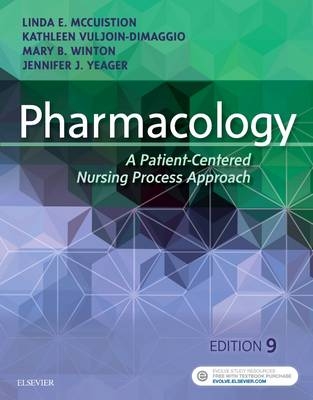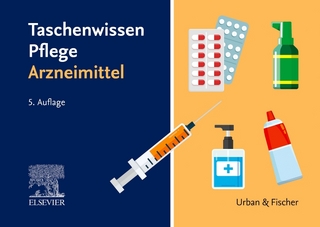
Pharmacology
Saunders (Verlag)
978-0-323-39916-6 (ISBN)
- Titel erscheint in neuer Auflage
- Artikel merken
UNIQUE! An extensive, color-coded Drug Calculations chapter presents six methods of dosage calculation, providing a helpful review and supplement to a dosage calculations textbook.
UNIQUE! Nursing Process summaries present patient care and drug therapy within the framework of each step of the nursing process, including information on patient teaching and cultural considerations.
UNIQUE! Illustrated overviews of normal anatomy and physiology open each unit and provide a critical foundational review for understanding how drugs work in each body system.
Chapter on safety and quality discusses medication errors, specific nursing measures to promote safety, National Patient Safety Goals, and many other safety issues and concerns.
Cultural considerations icons highlight important cultural considerations in the Nursing Process sections.
QSEN focus emphasizes patient-centered care, safety, quality, and collaboration and teamwork.
Application-level NCLEX Study Questions at the end of each chapter help prepare readers for the growing pharmacology coverage on the NCLEX Examination.
Consistent RN-standard chapter pedagogy includes objectives, outlines, key terms with page references, and activities on the Evolve companion website.
Coverage of prioritization throughout the text helps readers learn to prioritize nursing care and differentiate need-to-know from nice-to-know content.
NEW! Streamlined content and improved organization makes this edition even more user-friendly.
NEW! Patient Safety boxes reinforce concepts related to medication safety, and more.
NEW! New chapter on Transplant Drugs discusses key drugs prescribed for organ transplants.
NEW! Updated Prototype Drug Charts provide easy access to key information for the most commonly used drugs, including dosages, contraindications, drug-lab-food interactions, pharmacokinetics, and more.
NEW! New pregnancy categories regulations are addressed in all chapters where pregnancy categories were mentioned.
NEW! Additional QSEN icons will be included in boxes that discuss patient-centered care, teamwork and collaboration, evidence-based practice, quality improvement, safety, or informatics.
NEW! Expanded chapter on cultural considerations now includes new information on community-based nursing content.
NEW! Complementary and Alternative Therapies boxes (formerly Herbal Alert boxes) more appropriately reflect the content, which covers more than just safety information.
NEW! New or updated Critical thinking case studies are included at the end of every chapter to challenge readers to apply knowledge and analytical skills to realistic patient scenarios.
UNIT ONE: Introduction to Pharmacology
1. Drug Development and Ethical Considerations
2. Pharmacokinetics, Pharmacodynamics, and Pharmacogenetics
3. Cultural Considerations
4. Complementary and Alternative Therapies
5. Pediatric Considerations
6. Geriatric Considerations
7. Drugs in Substance Use Disorder
UNIT TWO: Pharmacotherapy and Drug Administration
8. The Nursing Process and Patient-Centered Care
9. Safety and Quality
10. Drug Administration
11. Drug Calculations
UNIT THREE: Maintenance of Homeostasis
12. Fluid Volume and Electrolytes
13. Vitamin and Mineral Replacement
14. Nutritional Support
UNIT FOUR: Autonomic Nervous System Drugs
15. Adrenergic Agonists and Antagonists
16. Cholinergic Agonists and Antagonists
UNIT FIVE: Central and Peripheral Nervous System Drugs
17. Stimulants
18. Depressants
19. Antiseizure Drugs
20. Drugs for Parkinsonism and Alzheimer's Disease
21. Drugs for Neuromuscular Disorders and Muscle Spasms
UNIT SIX: Mental and Behavioral Health Drugs
22. Antipsychotics and Anxiolytics
23. Antidepressants and Mood Stabilizers
UNIT SEVEN: Pain and Inflammation Management Drugs
24. Antiinflammatories
25. Analgesics
UNIT EIGHT: Antimicrobial Drugs
26. Antibacterials
27. Antituberculars, Antifungals, and Antivirals
28. Peptides, Antimalarials, and Anthelmintics
UNIT NINE: Immunologic Drugs
29. HIV- and AIDS-Related Drugs
30. Transplant Drugs
31. Vaccines
UNIT TEN: Antineoplastics and Biologic Response Modifiers
32. Anticancer Drugs
33. Targeted Therapies to Treat Cancer
34. Biologic Response Modifiers
UNIT ELEVEN: Respiratory Drugs
35. Upper Respiratory Disorders
36. Lower Respiratory Disorders
UNIT TWELVE: Cardiovascular Drugs
37. Cardiac Glycosides, Antianginals, and Antidysrhythmics
38. Diuretics
39. Antihypertensives
40. Anticoagulants, Antiplatelets, and Thrombolytics
41. Antihyperlipidemics and Peripheral Vasodilators
UNIT THIRTEEN: Gastrointestinal Drugs
42. Gastrointestinal Tract Disorders
43. Antiulcer Drugs
UNIT FOURTEEN: Eye, Ear, and Skin Drugs
44. Eye and Ear Disorders
45. Dermatologic Disorders
UNIT FIFTEEN: Endocrine Drugs
46. Pituitary, Thyroid, Parathyroid, and Adrenal Disorders
47. Antidiabetics
UNIT SIXTEEN: Renal and Urologic Drugs
48. Urinary Disorders
UNIT SEVENTEEN: Reproductive and Gender-Related Drugs
49. Pregnancy and Preterm Labor
50. Labor, Delivery, and Postpartum
51. Neonatal and Newborn 52. Women's Reproductive Health
53. Men's Reproductive Health
54. Sexually Transmitted Infections
UNIT EIGHTEEN: Emergency Drugs
55. Adult and Pediatric Emergency Drugs
| Erscheinungsdatum | 27.04.2017 |
|---|---|
| Zusatzinfo | Approx. 300 illustrations (300 in full color); Illustrations |
| Verlagsort | Philadelphia |
| Sprache | englisch |
| Maße | 216 x 276 mm |
| Gewicht | 1900 g |
| Themenwelt | Medizin / Pharmazie ► Pflege ► Ausbildung / Prüfung |
| ISBN-10 | 0-323-39916-9 / 0323399169 |
| ISBN-13 | 978-0-323-39916-6 / 9780323399166 |
| Zustand | Neuware |
| Haben Sie eine Frage zum Produkt? |
aus dem Bereich



